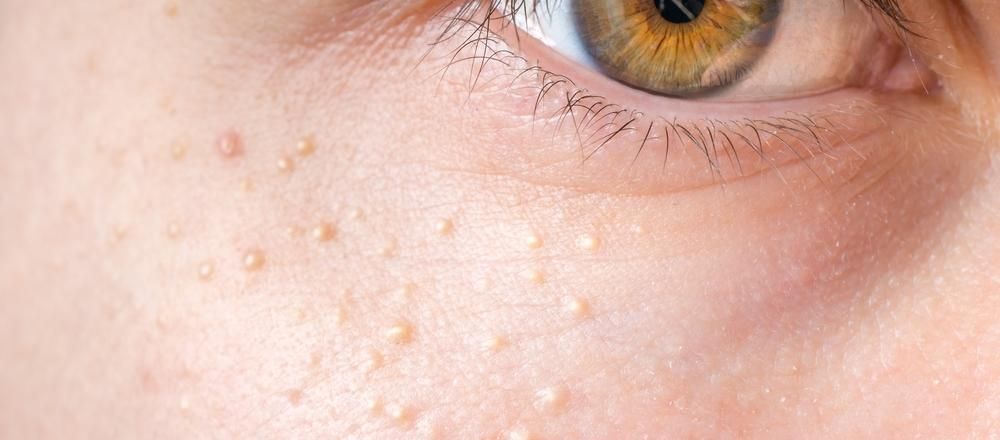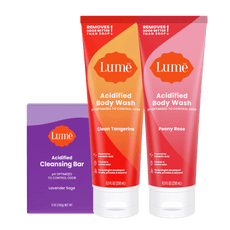
Facial Milia Cysts: A Quick Guide to Understanding, Preventing, and Eliminating Them
by Ashley Cummings
Facial milia cysts are clusters of small 1 to 2 millimeter yellow or white cysts that appear on your eyelids, the tops of your cheeks, or other places on your face.
These cysts form when the protein, keratin, gets trapped under your skin. While milia cysts are not dangerous, they can be a challenge to get rid of.
Let’s take a closer look at some of the different kinds of milia cysts, how you can prevent them, and a simple and effective home remedy.
Different Kinds of Milia Cysts
There are different causes and kinds of milia cysts. Here is a quick overview of the different types of milia cysts, ranging from the most common to the least common.
Neonatal Milia
Neonatal milia are those cute white bumps on newborn babies’ faces (everything on a newborn is adorable, right?). These bumps are uniform in size, white, and will usually appear right at birth.
Doctors will warn you not to pop these bumps. Stick to this advice (no matter how big of a pimple-popping addict you are).
Why? Because milia are not pimples, and they will disappear on their own after a few weeks. Plus, it’s super rude to squeeze anything on the face of a tiny human aggressively.
Primary Milia
Primary milia appear in children and adults and can affect the eyelids, cheeks, nasal crease, forehead, and sometimes genitals. Primary milia are common, treatable, and usually disappear on their own in a few weeks—provided you cleanse your face regularly and with the right products.
Traumatic Milia (Secondary Milia)
Another common type of milia is a side effect of any injury to the skin. If you get a burn, experience blistering or an allergic reaction, get a bad sunburn, or go through certain types of heavy facial treatments, you may experience traumatic milia while you’re healing.
Milia from Medication
Milia cysts can be a side effect of some medications. These cysts will disappear with the discontinued use of the prescription or shortly after you finish your medication.
Milia en Plaque
Milia can be grouped in a flat patch with a well-defined border. This condition is uncommon, but it has a distinct look. Milia en plaque looks like your face is wearing a milia nametag on the eyelids, behind the ears, on the cheeks, or on the jawline.
For treatments for milia en plaque, seek the advice of your dermatologist. Seeing a doctor is essential since these cysts are often associated with other skin issues.
Prevention and Home Remedies for Facial Milia Cysts
It’s important to remember that not all milia are preventable. For example, 50% of newborns will have neonatal milia, but the bumps will disappear within just a few weeks. Additionally, it may be necessary for you to complete a doctor-prescribed round of medication. Milia could be a side effect, but these bumps are not harmful and will typically disappear in a few weeks, so you shouldn’t stop taking any necessary medications.
For other types of milia, you can take some preventative measures to reduce the risk of milia cysts. Here are some general guidelines:
1. Limit sun exposure. If you’re planning an outdoor adventure, wear sunscreen, spend time in the shade, and wear a hat. It’s also wise to invest in a daily SPF moisturizer or stand-alone sunscreen.
2. Mind your allergies. Make it a habit to read the labels of your skincare products, especially if there is a particular ingredient that causes allergic reactions.
3. Avoid harsh chemical peels. If you are prone to milia cysts, take it easy on your next spa day. Instead of getting an abrasive chemical peel, opt for a facial that uses natural products and less intense exfoliation methods.
4. Start exfoliating. If you’re not huge into skincare, you don’t need to adopt a 15-step skincare regime. However, remember milia are a result of keratin proteins getting trapped under your skin. As such, adding a light exfoliant to your skincare routine 2-3 times a week will be helpful.
5. Steam your pores. Steaming your pores before you use a gentle facial soap will help you reduce the risk of getting facial milia cysts. Some people use a steaming tool and others use the old fashioned method—placing a towel over your head and catching the steam from a bowl of boiling hot water. Just make sure to be careful and test the heat of the steam on both devices so you don’t burn yourself. Steam opens the pores, making it easier for your facial cleanser to do its job.
6. Avoid oily skincare products and thick creams. Oily skincare products and thick creams can block your pores. Opt for natural, lighter facial soaps and cleansers.
If you are prone to facial milia cysts and are trying to eliminate them or reduce how often you get them, here is the most favorable treatment.
Treat Your Facial Milia Cysts by Using Lume Soap
The best way to treat facial milia cysts is to take care of your skin by using a gentle facial soap or cleanser.
There are several facial soaps and cleansers on the market, but not all of them treat milia cysts. We recommend a soap that is gentle, free of harmful ingredients, naturally moisturizing, and that cleanses deeply.
Lume Soap For Face & Body is doctor developed and does not contain any chemical antibacterial agents, parabens, phthalates, or sodium lauryl sulfate. This means Lume will cleanse the keratin from your pores, without any irritating ingredients.
Lume Soap is triple milled for higher quality and a rich, foaming lather. And you can use it on your hands or anywhere else on your body. How is that for an all around win?!
But, you don’t have to take our word for it. People are finding that Lume Soap helps prevent facial milia cysts:
“I had horrible facial milia cysts for the last 2-3 years. I even had two different facial surgeries done to try to remove large ones. Nothing seemed to help...Within TWO DAYS of Lume soap use, the cysts began to go away & are now almost completely gone!! I'm still in shock!! I will NEVER, EVER use another soap!!"
-Nancy
The team here at Lume knows you’ll love our soap, too. Try one of our luxurious best selling bars today!
Join in on the Lume Love today.
Categories
Recent Articles
- Your New Indulgence: Introducing Vanilla Bliss
April 04, 2025
- Feminine Hygiene Myths: A Tale As Old As Time
March 24, 2025
- Do Showers Control Body Odor?
March 18, 2025
- The Skin Loving Benefits of Mandelic Acid
February 28, 2025
- Why Is Acid In My Deodorant?
February 28, 2025
- What Are AHAs?
February 28, 2025
- 3 Helpful Tips For Getting Started
February 28, 2025
- Unlocking Smoother Looking Skin: Lume's Guide to Managing KP
January 29, 2025
- Drier Days Are In Your Pits’ Future!
January 15, 2025
- This Spray Slays
January 10, 2025
















